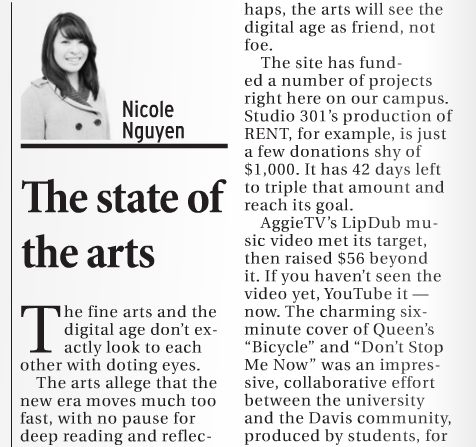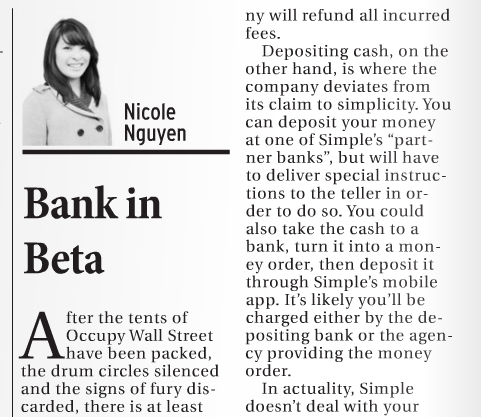Appeared in The California Aggie on March 5, 2012
The fine arts and the digital age don’t exactly look to each other with doting eyes.
The arts allege that the new era moves much too fast, with no pause for deep reading and reflection. The digital age retorts that fine art is an ancient, outdated practice in a mechanical time. They fundamentally undermine each another — one champions tangibility and sensory experience, while the other is based completely in a virtual reality.
Modern artists, of course, have embraced cyberspace as a platform for self-promotion and a vehicle for a new kind of creativity. But these two disciplines – science and the humanities – are frequently at odds for funding. A recent development, however, convinced me that this is no longer the case.
Kickstarter is a website that helps artists and entrepreneurs fund not only the fine arts, but all kinds of creative projects by soliciting the largest collective of people in the world — internet users. Commoners like you and me can become venture capitalists with a few bucks and a click of a button.
Carl Franzen of Talking Points Memo recently reported that Kickstarter is slated to contribute more funding to creative endeavors than the National Endowment for the Arts (NEA) this year. It’s a huge revelation, considering that the NEA is the federal agency responsible for supporting artistic excellence, not to mention the most prominent funding source for arts organizations in the nation.
Our dire economic and political situation could be the reason why NEA’s budget is so limited. Cash-strapped Americans and small government advocates haven’t been kind to the humanities, which is why music and arts education have dwindled to a trickle. But the crux of the matter is that Kickstarter could serve to fill that void. Then, perhaps, the arts will see the digital age as friend, not foe.
The site has funded a number of projects right here on our campus. Studio 301’s production of RENT, for example, is just a few donations shy of $1,000. It has 42 days left to triple that amount and reach its goal.
AggieTV’s LipDub music video met its target, then raised $56 beyond it. If you haven’t seen the video yet, YouTube it — now. The charming six-minute cover of Queen’s “Bicycle” and “Don’t Stop Me Now” was an impressive, collaborative effort between the university and the Davis community, produced by students, for students. And Kickstarter made it possible.
Rachel Agana, who graduated from UC Davis last year, was AggieTV’s online producer for the event.
Support the arts at the UC Davis Downtown Store this Friday where NICOLE NGUYEN and fellow printmakers will be selling their work. More shameless promotion at niknguyen@ucdavis.edu.


